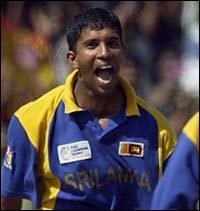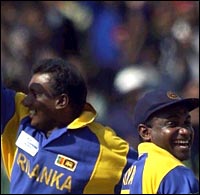History repeats
Daniel Laidlaw
First, to refute a theory, the notion that Australia had not been "tested"
in recent games and thus might not have been prepared for a demanding
semi-final against Sri Lanka: New Zealand, eclipsed by 164 runs, were the
reigning competition champions who had recently kept Australia out of their
home one-day finals. That match was a test. Because Australia won it
convincingly to pass with flying colours did not make it any less so.
The seven-wicket thrashing inflicted by Sri Lanka was not a result of
failing to be previously tested. The Australians knew, or should have known,
exactly what they were going to face in the semi-finals. The loss occurred
for all too familiar reasons, as in the tri-series final against the same
opponents at Premadasa three years ago and on numerous other occasions on
the subcontinent at Test level - lack of facility against spin. It is the
same old story, which has changed little across the 1990s, be it in Tests
or, in this case, one-day internationals.
 Australia had to expect a slow, dusty, spinning pitch suited to Sri Lanka's
strengths, which is exactly what they received. In came Kumara Dharmasena,
giving the hosts a three-pronged frontline spin attack, with DeSilva and
Jayasuriya for support. The mistake, from Australia's point of view,
apparently lay in their preparation for the match. If they thought the key
to flourishing against Sri Lanka lay in combating Muralitharan alone, they
were badly mistaken, for that plan overlooked the often equally insuperable
smothering ability of the rest of the attack, in favourable conditions.
Australia had to expect a slow, dusty, spinning pitch suited to Sri Lanka's
strengths, which is exactly what they received. In came Kumara Dharmasena,
giving the hosts a three-pronged frontline spin attack, with DeSilva and
Jayasuriya for support. The mistake, from Australia's point of view,
apparently lay in their preparation for the match. If they thought the key
to flourishing against Sri Lanka lay in combating Muralitharan alone, they
were badly mistaken, for that plan overlooked the often equally insuperable
smothering ability of the rest of the attack, in favourable conditions.
Aussie coach John Buchanan was quoted in the lead-up to the semi-final as
more or less saying the key to playing Muralitharan was to dominate the rest
of the attack, ensuring he entered the game on their terms rather than his.
Thus, he could be seen off without becoming an important factor, as New
Zealand's Daniel Vettori was in the group game. One crucial difference,
however: Vettori was New Zealand's sole spinner (discounting five Chris
Harris overs). Sri Lanka effectively played five. And of the 48.4 overs
bowled, they collectively delivered 39.4 of them. It would have been 41, had
Australia managed to survive that long.
Chaminda Vaas bowled seven overs, Pulasthi Gunaratne a token 2. The figures
tell it all. Against seam, Australia were a blistering 42/0 after five
overs. Once spin was first introduced through the agency of Dharmasena in
the sixth over, they were 10/120 from 43.4 overs. From the time Hayden was
out until Watson was dismissed, it read a dismal 7/58 from 25.5.
Unfortunately, when spinners bowl 80 per cent of the overs, dominating at a
rate of eight per over for a mere five overs of seam bowling becomes rather
insignificant. An alternate strategy needs to be devised. So much for
leaving the playing of spin to the individual batsmen.
If it is too much of a generalisation to speak of Sri Lanka's spinners
collectively, then it is because Australia were probably too specific in
singling Murali out as their main threat. They have, after all, lost one-day
internationals in the past to the bowling of Sachin Tendulkar. They needed
to consider how they were going to reach a competitive total in an innings
in which 35+ overs were always going to come from slow bowlers.
It is, perhaps, something of a joke to see spinners operating at both ends -
legitimised by the conditions - from the sixth over onwards of a one-day
international. However, those were the prevailing conditions, and Australia
did possess the advantage of batting first. History was to repeat itself,
though, as they proceeded to cast it away.
 Before his final over cost seven, Aravinda DeSilva had remarkable figures
of 9-2-9-1. He got Hayden in his first, the seventh, when the left-hander
charged a straight ball and was bowled attempting to hit across the line. It
was a rare mistake from Hayden and he clearly knew it; it established the
pattern of the innings thereafter. Gilchrist skied Dharmasena to cover off a
leading edge next over. Ponting was lbw to Vaas by one that seamed back and
Lehmann, improvisational and the middle-order's best player of slow bowling,
was run out for nought. Australia had lost 4/8 in 37 balls and when
Muralitharan was introduced for the 18th over were 64/4, which certainly
qualified as "coming on on his terms."
Before his final over cost seven, Aravinda DeSilva had remarkable figures
of 9-2-9-1. He got Hayden in his first, the seventh, when the left-hander
charged a straight ball and was bowled attempting to hit across the line. It
was a rare mistake from Hayden and he clearly knew it; it established the
pattern of the innings thereafter. Gilchrist skied Dharmasena to cover off a
leading edge next over. Ponting was lbw to Vaas by one that seamed back and
Lehmann, improvisational and the middle-order's best player of slow bowling,
was run out for nought. Australia had lost 4/8 in 37 balls and when
Muralitharan was introduced for the 18th over were 64/4, which certainly
qualified as "coming on on his terms."
It would be wrong to attribute the collapse solely to incapacity against the
turning ball or a flawed preparation, though. Ponting should have been given
leg-before to Vaas the previous over and there were two run outs, with at
least two other earlier chances. It appeared that a great emphasis had been
placed on rotating the strike to break the stranglehold, but it was done in
too reckless a fashion. Clearly, the early introduction of DeSilva was a
masterstroke, if one driven by necessity rather than design. If he and
Dharmasena had taken the new ball, Australia may not have reached 120.
It was Sri Lanka's batsmen, ultimately, who could afford to apply Buchanan's
plan for Muralitharan to Shane Warne. With Lehmann Australia's only other
slow bowler, it was Jayasuriya and Atapattu who ensured Warne entered the
game on their terms, to be seen off for only the loss of the captain to a
self-pronounced Warne "jaffa."
In what was reputedly viewed in Sri Lanka as their biggest game since the
1996 World Cup final, history repeated itself. For Australia, too, history
had also been repeated, albeit entirely the wrong kind. Fortunately for
Australia, in no way was this game an indicator of what to expect at the
World Cup, either for them or Sri Lanka.
More Columns
Mail Daniel Laidlaw